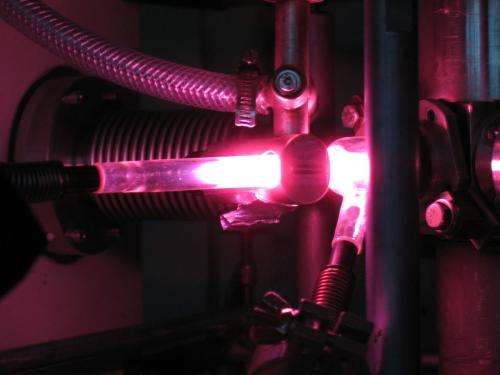January 13, 2015 report
Researchers find aldehydes in ices meant to simulate interstellar molecular clouds

(Phys.org)—A team of researchers working in France has detected the presence of aldehydes in ice samples in their lab which were created to simulate material found in interstellar molecular clouds. In their paper published in Proceedings of the National Academy of Sciences, the team describes their experiments and why they believe what they found adds credence to the idea that life came to Earth from a comet.
For time immemorial humans have pondered the question of how we got here—where did life come from, how did it start? We still have no real answers, but scientists are beginning to agree that life most likely got its start here courtesy of a comet or other celestial body. To test that possibility, researchers have been studying molecular clouds in interstellar space; in particular, the ices that form in them—scientists theorize that stars, planets and other bodies take their form from such ices. To test the whole idea researchers have been creating ices in labs that are believed to be similar to those out there in space, and then subjecting them to similar conditions to see if they lead to possibly life generating chemistries. Prior research has found that amino acids can form under such conditions, which would seem a natural precursor to life. In this new effort, the researchers looked for aldehydes, another class of organic compounds believed to be likely precursors.
The team created the simulated ices in simulated clouds and subjected them to the rigors of simulated space and then analyzed the results with multidimensional gas chromatography and time-of-flight mass spectrometry. They found 10 aldehydes which included sugar-related glycolaldehyde and glyceraldehydes, which many researchers believe were very likely intermediaries towards the eventual synthesis of ribonucleotides.
The results by the research team do not prove anything of course, but they do offer other researchers a target to aim for—if other researchers can find evidence of the same sort of chemistry in ices in interstellar molecular clouds (or in comets that come from them) it would go a long way towards proving that life began here (and possibly elsewhere) as the result of space travelers such as comets.
More information: Aldehydes and sugars from evolved precometary ice analogs: Importance of ices in astrochemical and prebiotic evolution, Pierre de Marcellus, PNAS, DOI: 10.1073/pnas.1418602112
Abstract
Evolved interstellar ices observed in dense protostellar molecular clouds may arguably be considered as part of precometary materials that will later fall on primitive telluric planets, bringing a wealth of complex organic compounds. In our laboratory, experiments reproducing the photo/thermochemical evolution of these ices are routinely performed. Following previous amino acid identifications in the resulting room temperature organic residues, we have searched for a different family of molecules of potential prebiotic interest. Using multidimensional gas chromatography coupled to time-of-flight mass spectrometry, we have detected 10 aldehydes, including the sugar-related glycolaldehyde and glyceraldehyde—two species considered as key prebiotic intermediates in the first steps toward the synthesis of ribonucleotides in a planetary environment. The presence of ammonia in water and methanol ice mixtures appears essential for the recovery of these aldehydes in the refractory organic residue at room temperature, although these products are free of nitrogen. We finally point out the importance of detecting aldehydes and sugars in extraterrestrial environments, in the gas phase of hot molecular clouds, and, more importantly, in comets and in primitive meteorites that have most probably seeded the Earth with organic material as early as 4.2 billion years ago.
Journal information: Proceedings of the National Academy of Sciences
© 2015 Phys.org





















